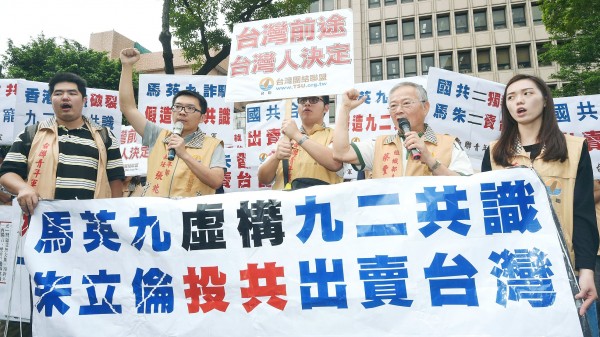《TAIPEI TIMES 焦點》 ‘1992 consensus’ foundation for ties: Ma

Members of the Taiwan Solidarity Union’s Youth Department yesterday rally outside the Mainland Affairs Council in Taipei to protest against President Ma Ying-jeou and New Taipei City Mayor and Chinese Nationalist Party (KMT) Chairman Eric Chu, saying that the two are selling out Taiwan using the “imaginary ‘1992 consensus.’” Photo: Wang Min-wei, Taipei Times
ACCEPT NO SUBSTITUTE: The president said yesterday’s visit to the Mainland Affairs Council was intended to commemorate previous high-level cross-strait meetings
By Shih Hsiu-chuan / Staff reporter
Echoing Chinese President Xi Jinping’s (習近平) description of consequences that Xi said would follow any change to the political formula that endorses the “one China” principle — the so-called “1992 consensus,” President Ma Ying-jeou (馬英九) yesterday said that the “political basis” for cross-strait interaction is “irreplaceable.”
Cross-strait relations prosper when they go along with the “1992 consensus,” wither when they part from it and decline into chaos when they go against it — as evidenced by the development of the cross-strait relationship over the past 23 years, Ma said in a speech at the Mainland Affairs Council.
Ma’s conclusions echoed Xi’s recent statement that challenging the “1992 consensus” would “trigger an earthquake and topple hills.”
Ma read a 4,650-word statement about the “1992 consensus,” titled “Peace and Prosperity: The Common Future of Cross-Strait Relations.”
Officials said the statement covered the origins and history of the phrase, and to tally the effects it has had on cross-strait ties.
The “1992 consensus,” a term former Chinese Nationalist Party (KMT) lawmaker Su Chi (蘇起) admitted making up in 2000 when he was head of the council, refers to a tacit understanding between the KMT and the Chinese government that both sides of the Taiwan Strait acknowledge that there is “one China,” with each side having its own interpretation of what “China” means.
Ma listed in the speech the “challenges” facing the adoption and implementation of the consensus and the various initiatives advocated, separately, by former Democratic Progressive Party (DPP) chairman Frank Hsieh (謝長廷), DPP Chairperson Tsai Ing-wen (蔡英文) and Taipei Mayor Ko Wen-je (柯文哲) as potential alternative frameworks for engaging with Beijing.
None of the proposals is a substitute for the “1992 consensus,” since “they were neither endorsed by Taiwanese society nor by [China],” Ma said.
However, the president said he “viewed positively” recent statements by Tsai and Ko.
Tsai has said that the DPP would maintain the “status quo” in cross-strait ties, examine cross-strait agreements under a supervision framework and continue negotiations if it returns to power.
Ko has proposed a “2015 point of view,” which respects cross-strait history and all of the agreements signed and agreed upon, as well as the “four mutuals”: mutual awareness, mutual understanding, mutual respect and mutual cooperation.
Nevertheless, “the proposals by Chairperson Tsai and Mayor Ko shun the issue of ‘one China,’” Ma said.
He said that his administration has made it “crystal clear” that the “one China” in the “1992 consensus” means the Republic of China (ROC).
Ma then posed two questions to Tsai, saying that Tsai, as her party’s nominee for next year’s presidential election, is duty-bound to provide unequivocal answers.
“First, what is the ‘status quo?’ Is it the policy of ‘no independence, no unification and no use of force,’ in line with the ROC Constitution and the peaceful development in cross-strait relations made possible by the ‘1992 consensus’ on ‘one China,’ with each side having its own interpretation?” Ma said.
“Second, how should the ‘status quo’ be maintained,” he said.
The “1992 consensus” is not a cure-all, but is the formula that can resolve problems hindering cross-strait relations — mainly disagreement over “one China” — maintain the “status quo” and bring peace and prosperity to the relationship, Ma said.
The consensus has provided the political basis that both sides willingly accepted, Ma said.
In interpreting what “one China” is in the formula, “we have to abide by the ROC Constitution,” Ma said. “Of course, the ‘one China’ for us is the ROC, not ‘two Chinas,’ ‘one China, one Taiwan’ or ‘Taiwanese independence.’”
Critics have said the KMT’s version of the “1992 consensus” is wishful thinking, as Beijing has never accepted the existence of the ROC and has been intolerant of symbols of the ROC’s sovereignty.
Chinese officials, including Xi, have said “the mainland and Taiwan belong to the same ‘one China,’” calling it a “core element” of the “1992 consensus” without mentioning “respective interpretations.”
Ma said the question of what the “one China” is “should be set aside.”
“Surely this is an issue that needs to be addressed, but in the future, not now. We must spend time and energy advancing exchanges, rather than interpreting what ‘one China’ is. Otherwise, we would be derailed in efforts to deal with other issues,” Ma said.
His visit to the council came ahead of New Taipei Mayor and KMT Chairman Eric Chu’s (朱立倫) planned trip to China and a meeting with Xi.
It was the second time Ma made such a visit to the council; the first was in July 2008, two months after he took to office.
Ma said yesterday’s visit was timed to commemorate the first high-level cross-strait meeting, which took place 22 years ago yesterday in Singapore, as well as a meeting between then-KMT chairman Lien Chan (連戰) and then-Chinese president Hu Jintao (胡錦濤) in Beijing 10 years ago.
“Chu has told me that he wished to consolidate and deepen the ‘1992 consensus’ [in his meeting with Xi] and incorporate the formula in Taiwan’s participation in regional economic integration,” Ma said.
“Our views on those issues are exactly identical,” he said.
新聞來源:TAIPEI TIMES

President Ma Ying-jeou yesterday stands in front of a row of Republic of China flags at the Mainland Affairs Council in Taipei. Photo: CNA












